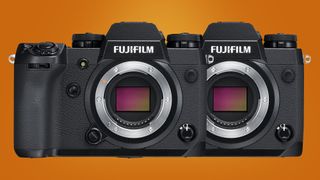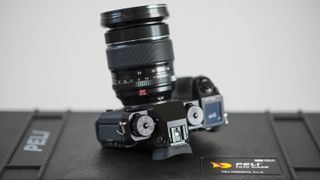Fujifilm X-H2 tipped to come in two versions, but what could they be?
Fujifilm could be planning to ape Sony and Panasonic...

The camera headlines might be dominated by full-frame powerhouses like the Canon EOS R3, but Fujifilm is still flying the flag for APS-C cameras with smaller sensors – and the latest rumors suggest it's even planning to launch two versions of its upcoming Fujifilm X-H2 flagship.
According to "trusted sources" at Fuji Rumors , "Fujifilm has not one but two Fujifilm X-H2 cameras scheduled for release in 2022." If true, that would be quite the launch for anyone who's looking for a new hybrid camera that can shoot a mix of stills and video.
Previous X-H2 rumors have tipped the mirrorless camera to have 8K video powers and introduce a next-generation X-Trans sensor for the first time in a few years on Fujifilm cameras. But the question is, why two X-H2 models?
- These are the best mirrorless cameras you can buy right now
- Or check out our guide to the world's best cameras for photography
- Fujifilm X-H2 release date, news, rumors and what we want to see
Fuji Rumors hasn't yet provided any more clues about what might differentiate the two X-H2 models. And it's not yet clear if the current leaked specs, including that new X-Trans sensor and sub-$2,500 price tag, will apply to both models. But we can make some educated guesses based on the recent histories of Fujifilm and its rivals.
Launching two or even three versions of the same camera is pretty commonplace. Panasonic, for example, released the Panasonic S1, Panasonic S1R and Panasonic S1H in 2019. The S1 and S1H both have 24.2MP full-frame sensors, but the S1H has some significant tweaks that make it a much more video-focused model.
Sony has employed a similar strategy with the Sony A7S III, although the key difference with that model is its unusually low-resolution 12MP sensor. This seems a less likely strategy for Fujifilm, which has traditionally taken pride in offering the same sensor and processor combination across most of its models. Instead, buyers are encouraged to decide the model for them based on other factors like design.
With this in mind, we think the two rumored Fujifilm X-H2 models are most likely to be built around the same sensor and processor, with the main differences being their design, grips and video focus. Either way, the X-H2 is certainly shaping up to a big launch, even if we have had to wait over four years for it.
Get daily insight, inspiration and deals in your inbox
Sign up for breaking news, reviews, opinion, top tech deals, and more.
Analysis: A picture slowly forms of Fuji's full-frame rival

The Fujifilm X-H2 is shaping up to be a huge launch for Fuji and camera fans in general. For advanced hobbyists and pros, the higher end of the market is now flooded with compelling full-frame models from Sony, Canon, Nikon and Panasonic. But Fujifilm's APS-C range has long offered a crucial alternative with slightly different characteristics, and it's good to hear that this variety is likely to continue into a new generation with the X-H2.
What's not yet clear is exactly how Fujifilm plans to differentiate the X-H2 from its full-frame rivals. One of the main issues with the X-H1, despite it excellent performance, was that it didn't quite carry the traditional charms of Fujifilm's X-series, like their travel-friendly size and weight.
This means that another possibility for the X-H2 is that its rumored two versions will have quite radically different designs, in the same way as the Fujifilm X-T3 and X-T30. In the case of the latter, the X-T3 was the pro-friendly all-rounder, while the X-T30 brought compact dimensions that made it one of the best travel cameras around.
Fujifilm has already shown that it can pack in-body image stabilization (IBIS), one of the hallmarks of the X-H1, into a smaller body with the recent Fujifilm X-S10. So a possible scenario for the X-H2 is that we'll get a compact vlogging camera (perhaps an X-H20), alongside a professional powerhouse with all the cooling needed to produce 8K video.
This would allow Fujifilm to offer both cameras at under the rumored sub-$2,500 price tag and position them as more affordable alternatives to their full-frame rivals. Sony, for example, effectively created a mini version of its Sony A7S III with the Sony A7C – and a similar strategy from Fuji seems not just sensible, but nigh-on essential if it's going to continue giving us compelling alternatives to its bigger rivals.
- These are the world's best video cameras

Mark is TechRadar's Senior news editor. Having worked in tech journalism for a ludicrous 17 years, Mark is now attempting to break the world record for the number of camera bags hoarded by one person. He was previously Cameras Editor at both TechRadar and Trusted Reviews, Acting editor on Stuff.tv, as well as Features editor and Reviews editor on Stuff magazine. As a freelancer, he's contributed to titles including The Sunday Times, FourFourTwo and Arena. And in a former life, he also won The Daily Telegraph's Young Sportswriter of the Year. But that was before he discovered the strange joys of getting up at 4am for a photo shoot in London's Square Mile.